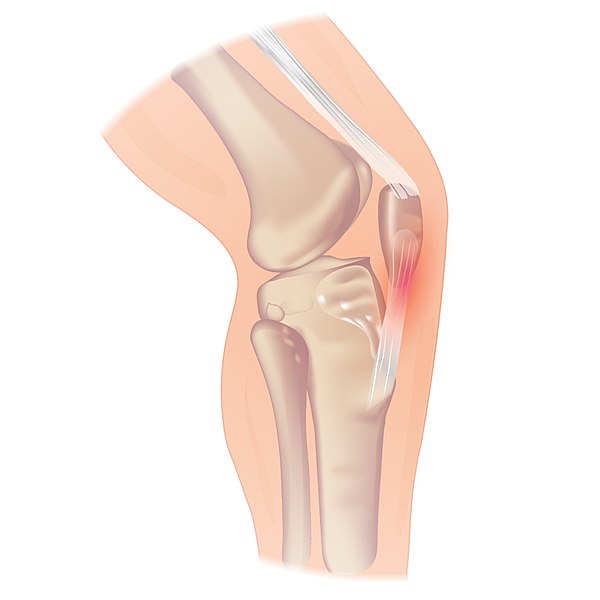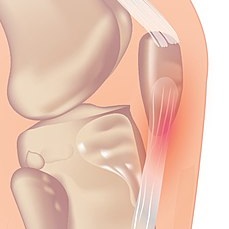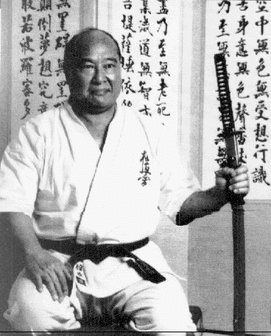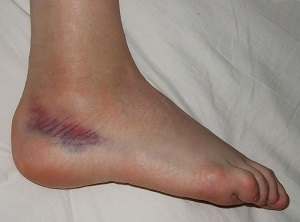Jumper’s knee, also known as Patellar tendonitis, is a condition characterized by inflammation of the patellar tendon. It is a common injury among athletes doing frequent jumping on hard surfaces.

Since my early age I have been struggling with intense pain in my kneecaps when doing my favorite sport. At the age of 10 I started to do the martial arts – or more specifically, Kyokushinkai Karate. This form of Karate involves a lot of jumping, kicking and joint extensions. This was in the early 90’s. As a kid I had been inspired by the Karate Kid movies starring Daniel-san and Mr. Miyagi, and I wanted to learn some cool moves on my own. So now, even after 30 years of practicing martial arts, I still enjoy to put on the white Gi (karate uniform) and take the stroll to the training hall to burn som calories and sweat. But there was a time when I thought that my martial arts days were over. The never-ending pain in my knees while doing the sport made me depressed, and I was at the brim of giving up what I had been doing for decades.
I was in my early thirties when I came aware that the constant pain in my knees was caused a condition called Jumper’s knee or “patellar tendonitis”. I had numerous instances where one of my knees would lock while walking or leaping. I couldn’t even go up the stairs in my house when it was at its worst. I was in excruciating pain all of the time. And things just got worse. I didn’t know what to do. Was this the end of my sporting activities?
Due to the pain, I consulted my doctor for advice on how to overcome the pain. I used to believe that my knees were broken and that I needed surgery. My doctor was not very helpful or understanding. He didn’t appear to have any prior knowledge of the subject. He suggested extra exercising to strengthen the knees, which surprised me. But I understood that all of the training was the root of my misery. He didn’t even suggest I see a physiotherapist for further examination and therapy, which was rather odd.
Dr. Google was my solution to the problem. Yes, doctor’s hate that people seek medical advices on the Internet, but to me it was for sure the best solution. I finally found a remedy for my severe problem after months of study and many trial and error. For me this was the ultimate treatment, which gave me back the hope for the future.
I’m neither a doctor or a physiotherapist, therefore I’m not qualified to give medical advice on treatment, but the recipe below did miracles for me. I now can do my favorite sport without the pain.
What is jumper’s knee?
Patellar tendonitis, or jumper’s knee, is a condition characterized by inflammation of the patellar tendon. This is the joint that joins your patella (kneecap) to your shin bone (tibia). Jumper’s knee weakens your tendon and, if left untreated, can result in tendon rips. Overuse of your knee joint, such as regular jumping on hard surfaces, can cause jumper’s knee.
It’s typically a sports-related injury caused by leg muscular contraction and the force of impact. Your tendon may become inflamed because of the repeated tension.
The most common symptoms are pain and tenderness around and below your kneecap, swelling, constant pain while jumping or walking, and pain when bending or straightening your leg. If you feel a lot of pain while massaging the tendon below the knee, it is most likely the condition called Jumper’s knee.
What is the treatment for a jumper’s knee?
The easiest way to treat jumper’s knee is for sure to cease doing whatever is causing the condition until it heals. For many of us this is not the preferred option. The injury might take months to heal, which will have an impact on our strength and physical condition which we have worked so hard to achieve.
Other options for treatment include nonsteroidal anti-inflammatory drugs (NSAIDs), which are medications that are used to treat inflammation (like ibuprofen or naproxen). Rest for a longer a period will help, and elevating your knee, and use ice packs to reduce the swelling. In some cases, stretching and strengthening exercises is recommended.
These types of treatment will work, but the symptoms of jumper’s knee will always come back when you resume the regular training. I always got the pain back just after a few weeks of exercise. Although the recommended treatments work, it is not viable in the long run.
My preferred treatment of jumper’s knee
Based on many years of trail and error I came up with a combination of eatable products and knee straps to reduce the discomfort of jumper’s knee.
Disclaimer
I would like to empathise that I am neither a physiotherapist nor a doctor, so following any of the advices below are at your own risk. I recommend you to consult your own doctor before your start any treatment on your own.
Let’s have a look at the specifics of my personal treatment for jumper’s knee discomfort. The treatment has not been verified or approved by a doctor.
Gelatin
Jumper’s knee is an inflammatory condition, as previously stated. Anti-inflammatory medications should not be used on a regular basis to treat the condition. It is preferable to take a more natural approach. Knox Gelatin – or any gelatine product you have access to – is one part of the solution. Personally I use the Norwegian brand called Gimsøy Gelatin powder, but any type of unflvored gelatine will suffice.
Collagen is the secret ingredient in gelatin. Gelatin is a flavorless, clear, and colorless culinary component made mostly from animal collagen. Collagen is the most significant structural protein in the connective tissues of the body.
Gelatin is one of the most powerful superfoods available, with benefits ranging from wrinkle reduction to weight loss. However, one benefit of gelatin that is often overlooked is that it aids in the reduction and healing of inflammation.
What you need know is that gelatin (specifically, the amino acids glycine and proline found in gelatin) has been demonstrated in multiple studies to decrease the inflammatory response. Glycine inhibits inflammation by acting on inflammatory cells like macrophages, according to one study. Another study found that glycine boosts adiponectin gene expression, implying that it could be utilized to treat obesity and type 2 diabetes by reducing inflammation. Glycine may also help to reduce tissue damage induced by persistent inflammation, according to one study.
There are numerous collagen products on the market, and the price varies a lot. Normal gelatin powder from the grocery store, on the other hand, is just as good as any of the commercial varieties.
L-glutamine
The second secret ingredient is L-glutamine.
Glutamine is an amino acid that plays an important role in the body’s metabolism. Amino acids are chemicals that have a variety of functions in the body.Their primary function is to act as building blocks for the proteins. Proteins are essential for organ function. They also have additional roles to play, such as moving chemicals through the bloodstream and battling dangerous viruses and bacteria.
It comes in two forms, like many other amino acids: L-glutamine and D-glutamine. L-glutamine is the type present in meals and supplements. Some supplements refer to it as L-glutamine, while others just refer to it as glutamine. While L-glutamine is used to make proteins and perform other functions, D-glutamine appears to be relatively unimportant in living organisms.
Glutamine is created in the muscles and transported to the organs that require it via the bloodstream. Glutamine may aid gut function, the immune system, and other essential processes in the body.
There are situations when your body’s glutamine requirements exceed its ability to manufacture it. During injury or disease it might be neccessary to obtain additional glutamine from supplements in the diet. Since glutamine is a necessary part of proteins, virtually any food containing protein will contain some amount of glutamine. Focusing on getting enough protein in your overall diet is an easy way to potentially increase the amount of glutamine you are consuming.
L-glutamine has proven to significantly increasing the collagen production in the human body – which in turn has an anti-inflammation effect. The combined comsumption of animal collagen and L-glutamine appears to have a positive effect on the treatment of jumper’s knee – at least in my case.
For more information about studies on L-glutamine and Collagen, please refer to
- Glutamine increases collagen gene transcription in cultured human fibroblasts
- Combination of BCAAs and glutamine enhances dermal collagen protein synthesis in protein
Calcium and Vitamins
Calcium, vitamin D and Vitamin K does not have an effect on inflammation, but the inflammation might weaken your bones. So, how can inflammation contribute to bone deterioration? The link is twofold: macrophage cells, which are plentiful in inflammation, and osteoclast cells, which tear down bone on a daily basis, have a close relationship. The activation of those osteoclast cells is also linked to the inflammatory cytokines that circulate throughout an inflamed body.
For better health, and to avoid osteoporosis, I have included additional calcium, vitamin D and K in my diet.
Knee strap
Jumper’s knee cannot be treated solely with food supplements. As soon as you resume your regular workout, the constant movement of the tendon when leaping will create irritation. My best recommendation for preventing future inflammation is to use a knee strap created specifically for jumper’s knee. The strap’s objective is to retrain the kneecap’s mobility. This tiny strap is very functional. Just be careful not to tighten it too much.
Personally, I prefer the Mueller Jumper’s Knee Strap, but any knee strap developed for the treatment of jumper’s knee will suffice.
For me the knee strap had limited effect by itself, and it worked best when combined with gelatin and L-glutamine.
Step-by-step guide
Jumper’s knee does not have a cure because it will most likely return once you begin your usual workout. However, you can lessen the severity of the symptoms and the length of time the injury lasts.
To get you started with your treatment of jumper’s knee I have made a short step-by-step guide:
- Add Gelantin and cold water
Add 1 table spoon of gelatin powder to a coffee cup. Add some cold water and stir. You should add enough cold water to at least cover the gelatin powder.
- Wait for 15 minutes
You should wait 15 minutes for the gelatin powder to partially dissolve in the cold water.
- Add L-glutamine and stir
Follow the L-glutamine daily consumption recommendations listed on the back of the container.
- Add boiling water
The gelatin and L-glutamine will now be dissolved in boiling water. You have the option of waiting for the mixture to cool down or adding cold water. You can add some orange juice or honey if you don’t like the taste, smell, or color.
I drink this strange-tasting mixture every morning, and it has helped me avoid most of the symptoms of jumper’s knee.
Now it is your turn to order gelatin, L-glutamine and a knee strap.
Summary
Fellow martial artists and athletes; I hope my experiences and proposed treatment will make your life easier and less painful.
The treatment is to decrease the inflammation by consuming animal products containing gelatin and L-glutamine, in combination with a knee strap, and rest.
Please let me know if you found this post helpful and it made a difference for you in the comments section below.
If you want to know more about my role as a karate instructor and my dojo, please visit the website of Gandsfjord Karate Club (in Norwegian only). You can also know more about the Coragi side-hustle by visiting the About page.



